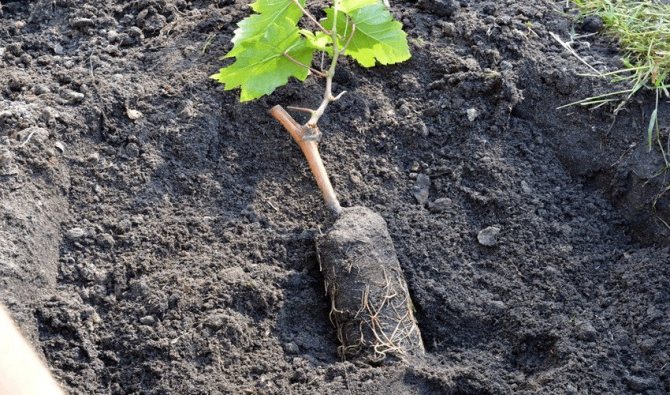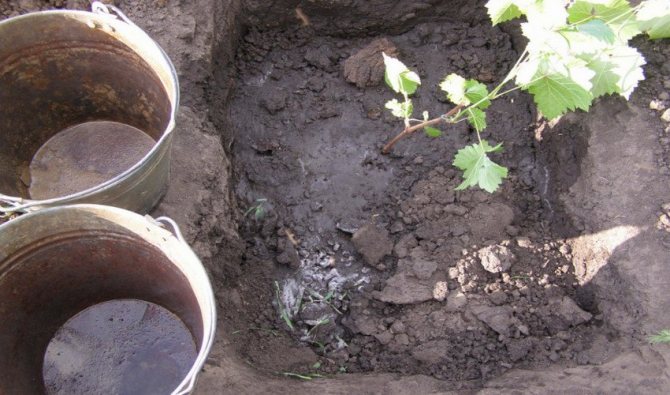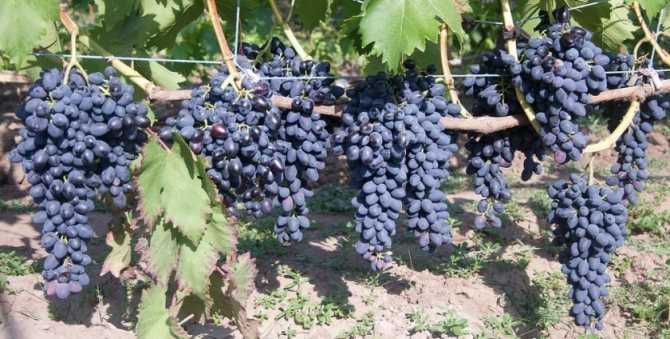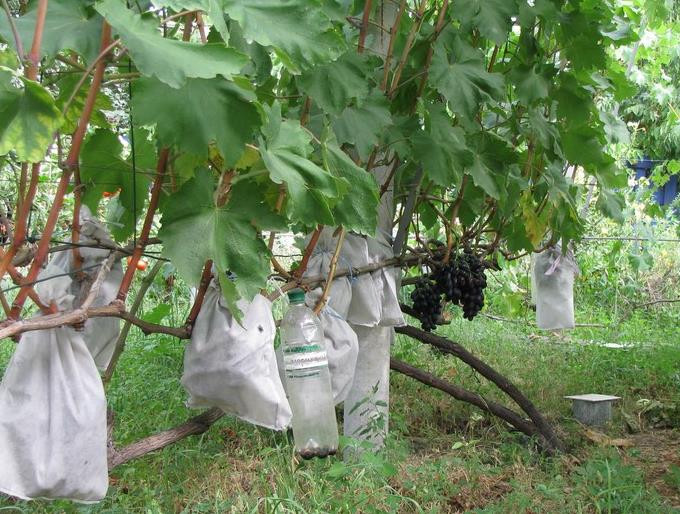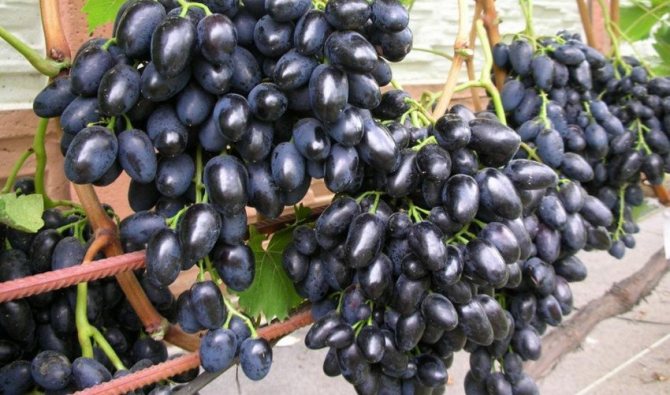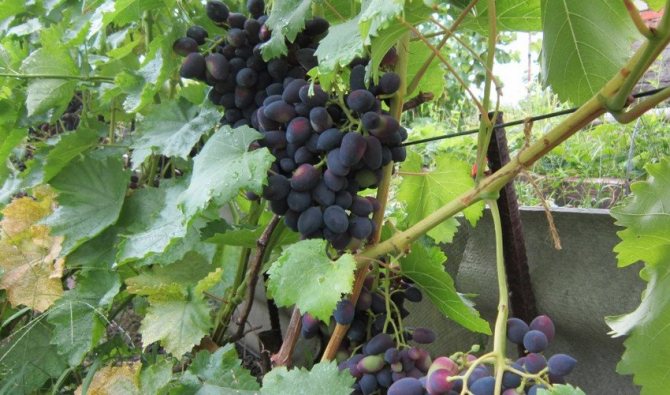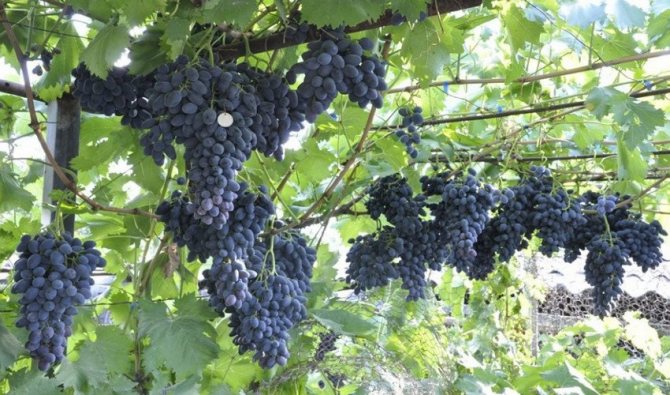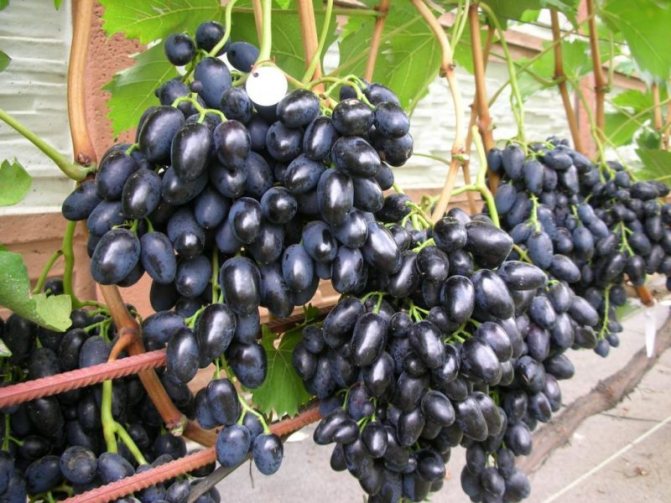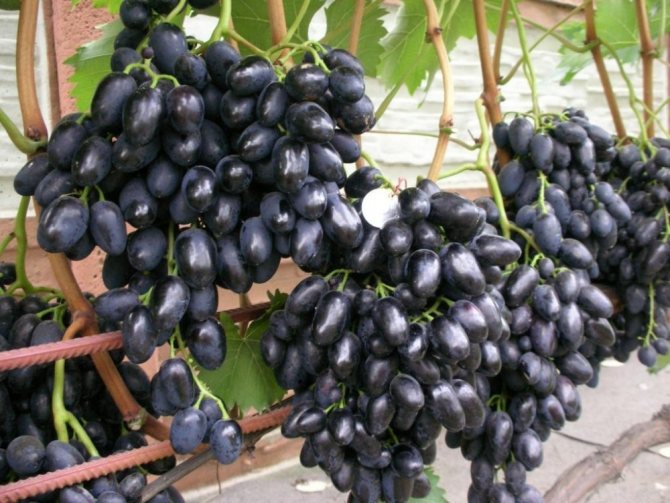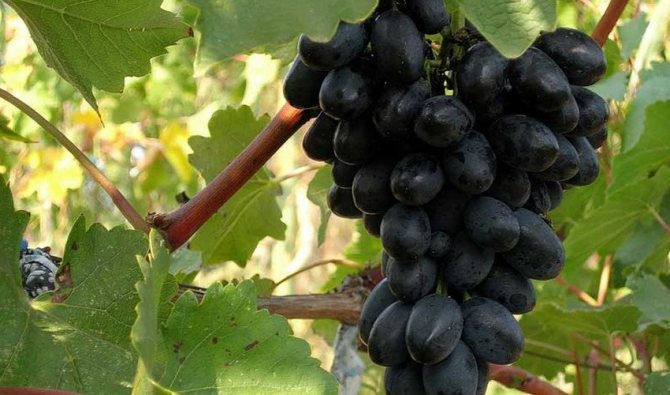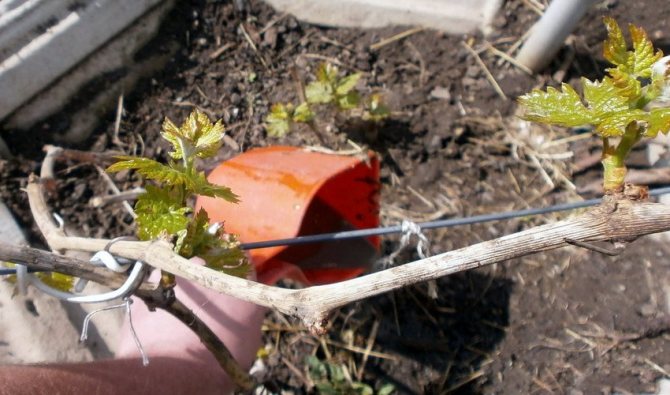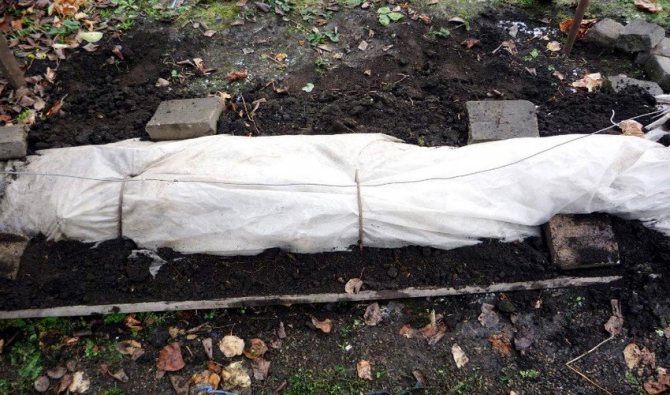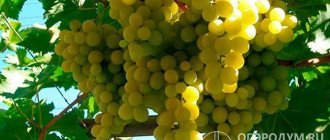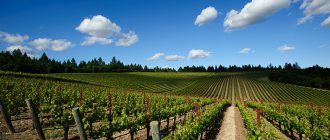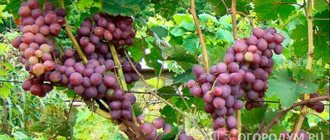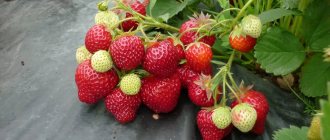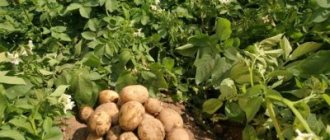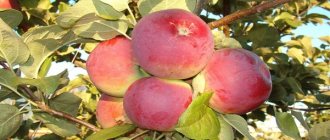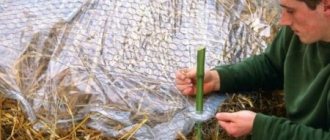What species does it belong to?
The grapes Nadezhda AZOS are popular among gardeners in Russia due to their excellent characteristics, which allow them to give a rich harvest that has sweet harmonious taste, in spite of severe weather conditionsin which he has to grow.
This vine is a dark blue (black) table variety.
REFERENCE INFORMATION: Table grapes are ready for consumption. (Does not require additional processing) And also, has a pleasant aroma, taste and attractive appearance, both berries and bunches in general.
Table varieties are also Carmacode, Bull's Eye and Zarya Nesvetaya.
How to plant correctly
Nadezhda Azos is an unpretentious plant. It does not cause much trouble, unpretentious care. However, some of the nuances regarding planting and cultivation should be taken into account by beginners in order to get a stable harvest.
See also
What year does the grape bear fruit after planting and what does the term depend on?
To read
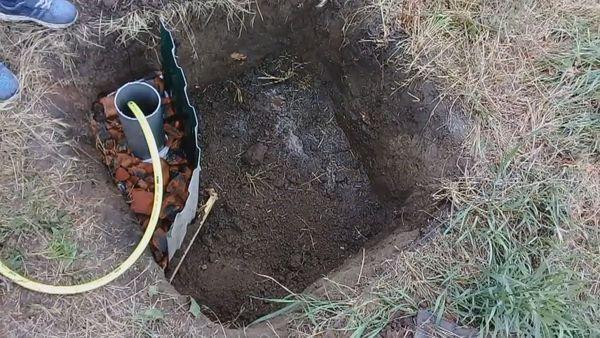
Timing recommendations
Planting on time is very important for this variety due to the poor rooting of the cuttings.
In any region, Nadezhda Azos grapes are planted in spring: in the south - at the beginning of May, in cold regions - after the middle of the month.
Conditions for successful planting: warm air (not lower than 15 degrees), warmed up to 10 degrees soil and water for irrigation.
Site selection and preparation
For successful planting and rooting of cuttings, it is important to choose a site and prepare it correctly. The place should be sunny, open to the south and sheltered to the north. Grapes need light to grow quickly. You can plant grapes near the walls of houses and other buildings facing south. At night they give the plant the heat collected during the day.
It is better to hide the bushes from the north wind behind a fence or buildings.
It is important to consider the composition of the soil on the site. Vine bushes should not be planted in swampy or saline areas and where rocky outcrops are close to the surface (less than a meter).
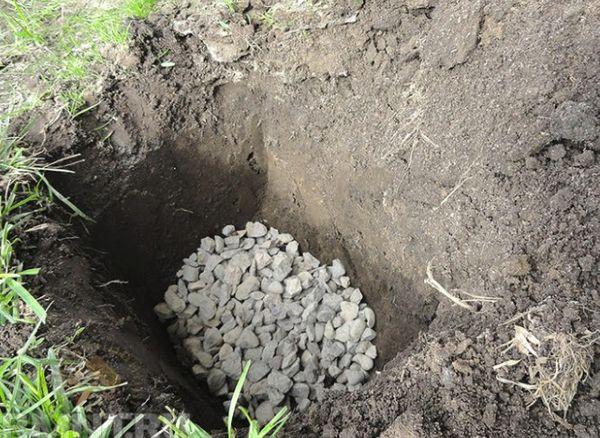

The vine thrives on sandstones and loams, grows well on black soil.
It is not recommended to place the bushes next to other grape varieties, as cross-pollination can affect the characteristics of the hybrid.
To prepare the site, you must perform the following steps:
- Clear the area from bushes, stones.
- Loosen the soil to 70-100 cm.
- If the soil is loose enough, the cuttings are planted in pits.
- If the soil is heavy, it is improved with humus, manure, crushed stone, sand.
How to choose and prepare planting material
The choice of seedlings for planting is an equally important matter in the cultivation of grape bushes. Experienced gardeners apply certain criteria to select good, healthy seedlings from bad ones.
Age
The best age for the bushes is from 1 to 2 years. They are considered the most viable. The younger the plant, the easier it will tolerate planting and adaptation.
Root system
In healthy and strong seedlings, the root system should be 3-4 processes. The thicker and more elastic they are, the more likely they are to take root.
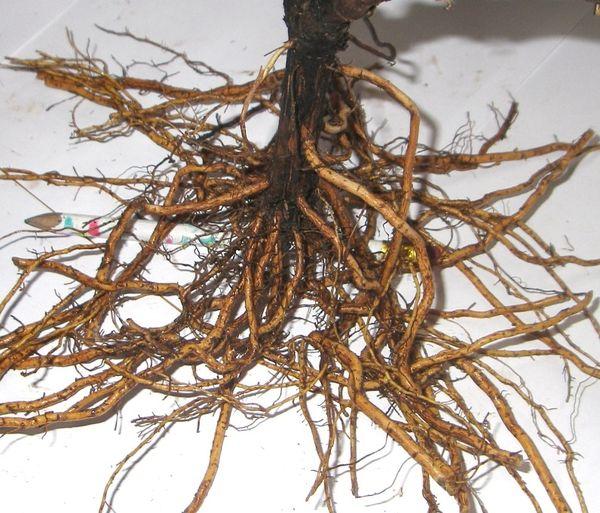

Length
The most optimal length for grape seedlings is from 30 to 40 cm.
Vine
The appearance of the bush is also taken into account when planting. In a healthy seedling, the trunk is absolutely even, the bark is not damaged. He may have one or two vines, they should not be too thin.
Landing scheme
Part of the soil is removed from the pit prepared for planting. Set the plant in the center, straighten the roots so that there is no emptiness under them. The earth is covered so that the root collar (the place of growth) is below the soil level. Then the earth is tamped and watered with 2 buckets of warm water.
A support is installed near the bushes. It will be needed to garter young shoots. If the bush grows next to the wall, it is planted at a slight slope, with the top towards the structure.
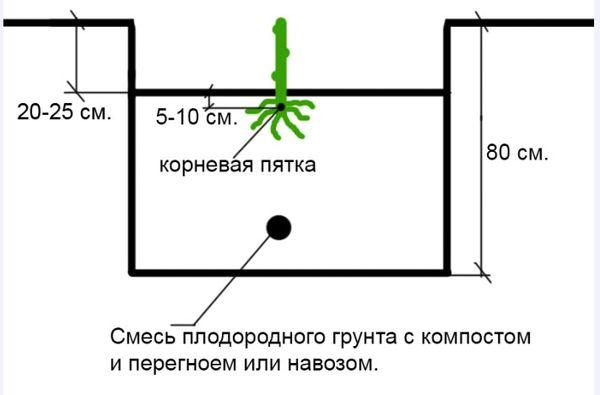

Advantages and disadvantages
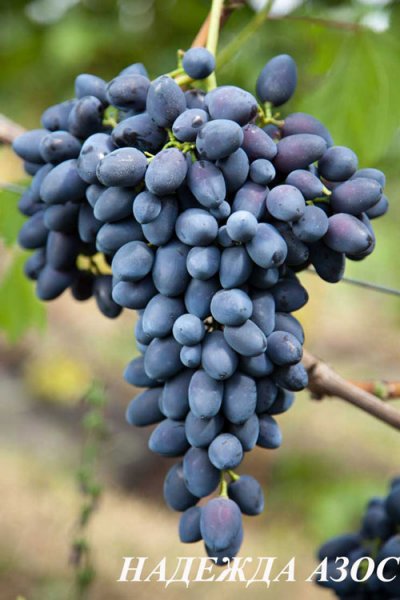

Strengths:
- Mild pleasant taste and aroma.
- Beautiful appearance of berries and neat bunches.
- Produces large yields consistently.
- The berries tolerate transportation well.
- High frost resistance.
- Good immunity to diseases.
- Virtually not damaged by wasps.
Weak sides:
- Pollination problems are possible if bad weather conditions occur during the flowering period.
- Poor rooting of cuttings.
- With heavy rainfall, the skin of the fruit may suffer.
- Due to the high degree of ripening of the crop, the bush may suffer from overload (the vine may break or the quality of the berries themselves will suffer).
- A slight tendency of berries to peas (quite rare).
pros
All cultures have their merits and demerits. Nadezhda Azos is no exception in this regard. Main advantages:
- high rates of total yield;
- fruiting stability;
- unusual appearance;
- resistance to low temperatures;
- resistance to major diseases;
- suitability for long-term transportation;
- high tasting score.
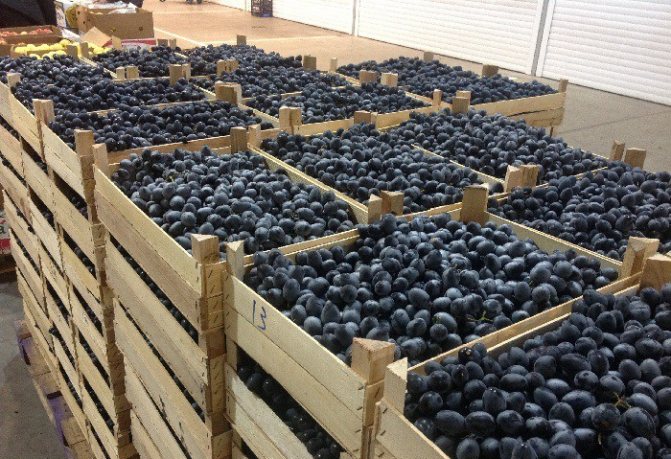

The variety is suitable for commercial cultivation.
The variety is rarely used in winemaking, the main purpose is sale, use in cooking, because excellent compotes, preserves, jams are obtained from the fruits... At the same time, berries are rarely frozen, since when frozen, as a rule, they lose their appearance, but taste and aroma are preserved.
Often, berries are used to make various cocktails, smoothies, and these cocktails will have a special taste if you process the berries, along with the peel
The variety is maximally resistant to the occurrence of powdery mildew or downy mildew.
It should be noted that resistance to low temperatures is also excellent - the plant can withstand frosts up to twenty-two degrees... This means that in the southern regions it does not need shelter, but in the regions of the middle lane and northern regions, sheltering grapes is a must.
and cons
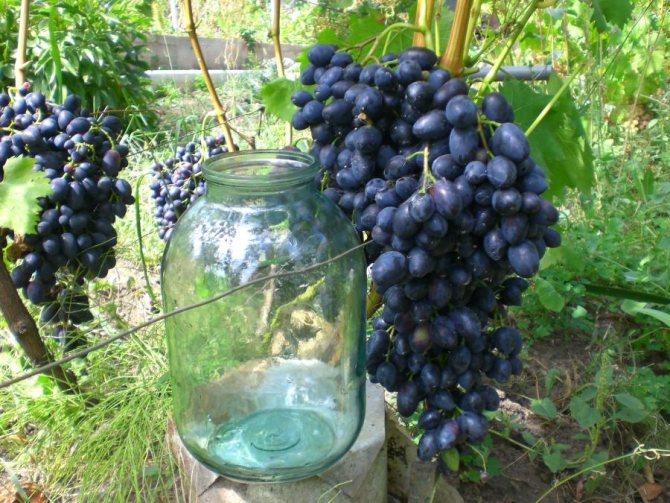

On one bush, brushes and berries of various sizes can grow.
Despite the impressive list of advantages, the variety also has disadvantages:
- the ability to overload in clusters in clusters;
- the possibility of slight peas;
- difficult self-pollination under adverse conditions;
- reduced adaptive properties;
- different sizes of fruits on one brush;
- sensitivity to moisture level.
In order to reduce congestion, it is necessary to constantly monitor the formation of brushes, to eliminate them in a timely manner.
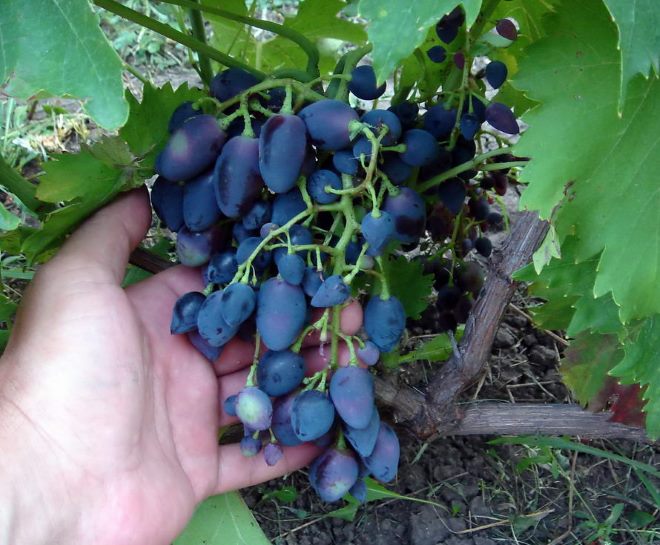

The variety suffers from peas a little, but within reason and on separate clusters.
During the second wave of fruiting, slight peas on the berries may be recorded. It is worth noting that the fruit units cannot greatly decrease due to the genetic properties of the plant for large-fruited. It is not uncommon to see that the peel on individual fruits is bursting. This happens for two reasons. The first reason may be that the level of humidity in the air is increased.
A similar phenomenon occurs during a long rainy period or at the end of this period. But also the fruits can burst if watering rules are not followed, that is, the plant is watered too often and abundantly.
Also, during the period of prolonged rains in grapes, there is a decrease in self-pollination ability.
Description of grape variety Nadezhda AZOS
The bunches have a conical shape, but at the same time they are loose, or branchy. The average weight of a bunch is 500-900 grams. The length of the leg of the brush is average. The number of bunches on one shoot is 1.2-1.6 pieces.
The berries have an elongated oval shape and a dark blue, medium-thick skin, covered with a waxy bloom. At the same time, the weight of the berry is 5-8 grams (volume 28x22 mm), which allows it to be classified as a large grape fruit.
Harmonious pleasant taste consists of a combination of acidity, which is 7-8 g / l, as well as sugar content, the value of which for this variety is determined by 15-17%. The pulp has a fleshy, crunchy texture.
The seeds have an average weight relative to the berry itself (up to 40 mg)
IMPORTANT: Nadezhda AZOS is a medium-early ripening grape variety (within 116-130 days). Ready fruits appear already in the second or early third decade of August and can hold out on the bush until the first frost without changing the taste.
The mid-early also includes Strashensky, Ataman Pavlyuk and Asya.
The vine is fast-growing with a high degree of maturity (2 / 3-6 / 7 of the total length). Bushes are vigorous with bisexual flowers. The leaves are smooth, large, with a dense degree of cobweb pubescence at the top of the young shoot. They have 5 lobes with an open petiole notch.
Description of the plant
Outwardly, the bushes of Nadezhda AZOS look quite impressive - powerful, vigorous with a large number of strong shoots. It is best not to plant the grapes too close to each other - the variety loves a lot of free space around. Gardeners call the degree of ripening of the vine of Nadezhda AZOS one of the best.
The shoots are densely covered with large leaves, quite competing in size with burdocks. The shape is classic for grapes, uneven, characterized by a deep cut. The cuttings are rather weakly rooted, so the seedlings can develop slowly.
The bushes look beautiful if you grow them in the country or in the yard of your own house - they will be a good decoration for a gazebo or a fence.
The bunches of Nadezhda AZOS are striking in size. On average, the weight of one is from 800 to 1500 grams, but often three kilograms each come across. Brushes of a beautiful, regular shape, very aesthetic look.
The planting density of berries is average, which has a very positive effect on their safety - all berries are ventilated and do not start to rot. In unfavorable years, the size of the crop may decrease, and the berries themselves may decrease in size, but this problem does not often arise.
The berries themselves are very beautiful, rather large in size. The shape is oval on average, slightly pointed at the end. The color of berries, close to ripeness, is a rich dark purple color, ripe berries are even almost black.
During rain and high humidity, overripe grapes can even crack right on the plant. True, after that, they become conscious and wither, and do not rot, therefore, they do not affect the rest of the crop in any way.
The pulp is fleshy. The percentage of sugar content is not very high, about 15%. The grapes have a classic flavor, without fruit additions. Not quite ripe berries can be slightly tart.
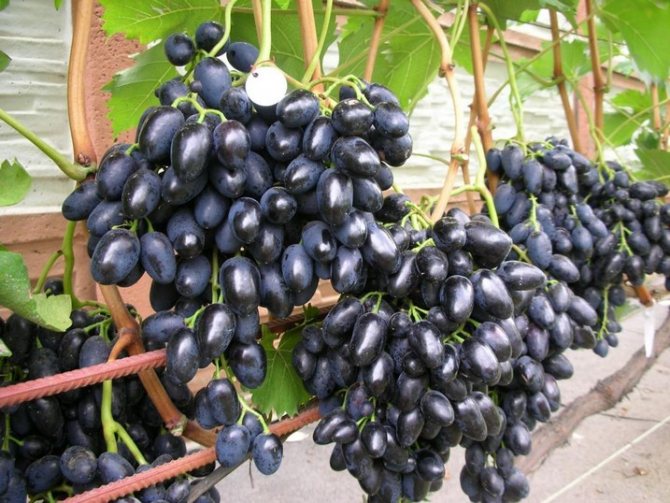

In general, Nadezhda AZOS belongs to unpretentious grape varieties. It is better to plant it in a sunny area, slightly even on a hill. Almost any soil will do.
- Watering should be carried out regularly, but focus on the condition of the earth at the roots. If it is dry, increase the amount of water, if it is wet, then decrease it.
- The variety reacts very positively to fertilizing, especially with potash or phosphorus fertilizers.
- Bushes need to be cut regularly - Nadezhda AZOS "loves" more free wood and freedom, so the crop develops faster when there is a lot of space.
Read also: Why do tomato leaves curl in a greenhouse: reasons, what to do, photos, videos
Photo
Next, check out the photos of the Nadezhda AZOS grape variety:
Harvesting and storage
Often at the end of August, the crop can be harvested from the bushes. Sometimes the dates can shift to the beginning of September.
Important! Since the stalks
«
Hopes AZOS
»
strong, best of allfor harvestinguse a pruner.
You can store bunches in several ways:
- hanging by a leg on a wire;
- in refrigeration chambers;
- in boxes, laying them leg up in one layer.
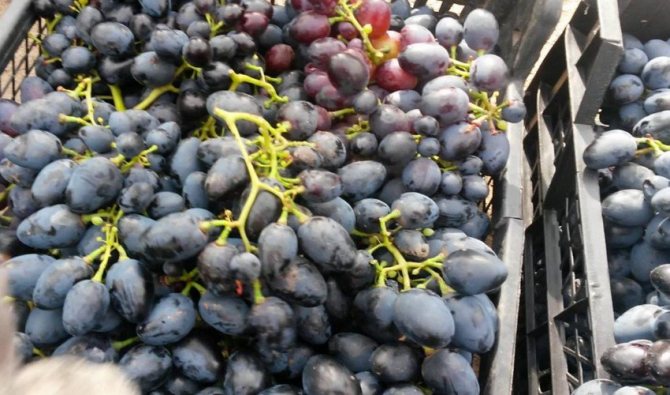

At room temperature, fruits can be stored for up to 2 months. They also lend themselves well to transportation.
Breeding history and breeding region
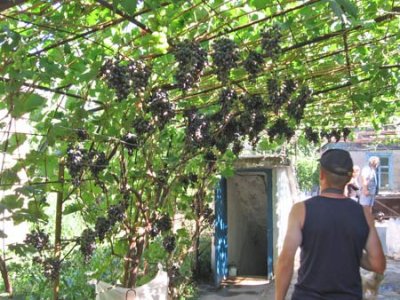

This grape variety was obtained at the Anapa Zonal Experimental Station of Viticulture and Winemaking (abbreviated AZOSViV) by crossing Moldova and Cardinal varieties in the period from 1963 to 1965.
REFERENCE INFORMATION: At the moment, the station has changed its name and now exists as the Federal State Budgetary Scientific Institution Anapa Zonal Experimental Station of Viticulture and Winemaking of the North Caucasian Zonal Research Institute of Horticulture and Viticulture (abbreviated as FGBNU Anapskaya ZOSViV NKZNIISiV).
The author of the interspecific hybrid, named Nadezhda AZOS, was NN Alpakova, who worked at the station for more than 30 years.
Reproduction methods
There are several ways to reproduce grapes. Each gardener chooses the method that is convenient for him.
Digging in shoots
A healthy vine, located at the level of the soil, is pinned to the ground in spring and sprinkled with soil in this place. By the end of the season, or next spring, roots appear at the pinning site, after which the vine can be cut off from the mother bush and planted separately.
Chubukami
Most often, they resort to planting pre-prepared cuttings (shanks). There are several requirements for the planting material. The handle should have at least 5 buds, 2 of which are left above the soil surface when planting. The root system of the grapes must be developed, but no dry areas.
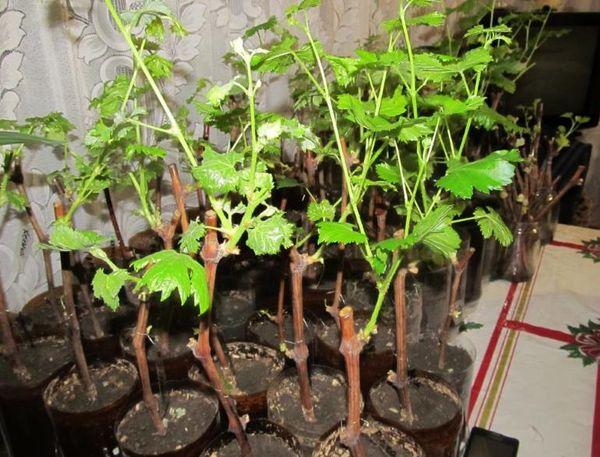

Grafting
Grafting of grapes is a rather complicated process, so it is carried out by experienced growers. Usually the variety is grafted onto a more hardy stock in order to improve its winter-hardy characteristics.
Characteristics
The grape Nadezhda AZOS was created specifically for the Russian latitudes, characterized by inconsistent, and most of the year and cold weather. Therefore, breeders bred a vine with increased frost resistance, capable of withstanding up to -22-26 degrees Celsius.
IMPORTANT: At low negative temperatures, the vine must be covered!
Frost-resistant varieties are Super Extra, Krasa Severa and Pink Flamingo.
The grapes of this species are equally resistant to drought, without requiring additional watering, and grows well on sandy and clay soils, giving a bountiful harvest. The fruitfulness of the shoots is 75-90%. Moreover, both the main shoots and stepchildren are capable of bearing fruit. In different climatic zones, the yield of this grape ranges from 160 centners to 5-8 tons per hectare. In a summer cottage, with good care, the bush can give up to 30 kg of berries.
IMPORTANT: When planting such large bushes in a summer cottage, in order to avoid injury to the plant by its own weight or strong wind, molding should be used. It is preferable to choose an arched or arbor shape of the structure.
Nadezhda AZOS is recognized as a complex resistant, unpretentious variety. It tolerates transportation well without losing its shape and is recognized as one of the best commercial or market grades.
Delight Ideal, Giovanni and Denisovsky.
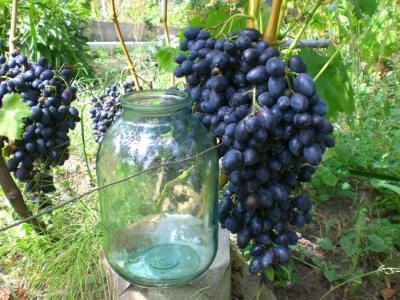

Vine propagation can be done in four ways:
- Vaccinations
- By dripping in the vine (this method is also known as "Shoot propagation")
- Carrying out shanks (cuttings)
- Planting ready-made grown cuttings (purchased or grown independently)
Cultivating Hope - Similarities and Differences
In planting and growing all three varieties of Nadezhda, there are common features and specific features of each variety.
Landing
Planting all three Nadezhd is no different from this operation for other grape varieties. A landing pit is being prepared in advance. In 2-3 months, the soil in it will be compacted, and the roots of the grapes will not fall into the voids. In a hole, the diameter and depth of which, depending on the grape planting area, can be from 0.5 to 1 meter, a support stake is driven in the center and filled in layers.
- On dense soils that do not allow water to pass through, the first to make a drainage 10-centimeter layer, consisting of crushed stone or fine gravel with sand.
- Further, regardless of the soil, three layers are poured approximately the same thickness as the first: fertile soil, humus and again fertile soil. Mix them thoroughly.
- The pit is filled with fertile soil, but not to the very top, leaving a recess for irrigation, into which 2-3 buckets of water are poured.
When it comes time to plant grapes, in the center of the prepared planting pit, soil is chosen so that the roots of the plant are freely located in the hole. They are spread out on an earthen mound poured inside, carefully covered with earth and tamped down. Water the plant with warm water in the volume of 2-3 buckets. When the soil absorbs water, a layer of humus, sawdust, cut grass, and other organic matter is poured around the planted grapes. This is called mulch. It will protect the soil under the grapes from drying out and compaction during watering and rains, and itself, gradually rotting, will become an additional fertilizing of the plant.
Since all three varieties of grapes under consideration have a low winter hardiness, it is better to plant young plants in spring.
Pruning
Autumn pruning of vines is one of the most important operations for:
- ensuring the normal growth and development of plants;
- getting a decent harvest from them;
- preparation of grapes for wintering.
Although in general it is carried out according to the general rules for the formation of grapes, for each of the varieties it has its own characteristics.
For Nadezhda AZOS, they recommend short pruning, that is, 2–4 eyes should be left on the shoot, there should be no more than 45 of them on the bush.
It is recommended to cut off the Aksai hope by 2–8 buds on the shoot and leave them no more than 35 on the bush.
For Nadezhda early - a very young and not fully studied variety, no clear recommendations have been found, one should adhere to the general method of pruning grapes, given that the bush is medium-sized.
Load rationing
All three Nadezhda grapes have large bunches. For their timely and high-quality ripening, and therefore for the berries to acquire the appropriate taste for the variety, to prevent peas, it is recommended to leave no more than one bunch on the shoot. Although some experienced growers, providing a high level of agricultural background, successfully grow two brushes. In any case, the number of bunches on the shoot must be normalized.
In addition, crop-laden vines should be well tied to the trellis so that the shoots do not break off.
Watering
As with other grape varieties, Nadezhda needs three watering must be done during the season for successful growth and fruiting: before flowering, after it, and after harvesting. In the periods between these stages of plant development, the need for additional watering is consistent with the weather in a particular season. In areas where winters are cold, so-called charging irrigation is often carried out in the fall after pruning the grapes and before sheltering it for the winter. It allows the plant to endure frost more easily.
Disease prevention
Of the three Nadezhd, the least resistant to the main diseases of grapes is Nadezhda Aksayskaya. One or two preventive treatments with fungicides will only be beneficial to her. They are especially relevant in a bad year. In this situation, they will not harm the other two Hopes. They are carried out during certain periods of the growing season of grapes:
- before blooming flowers;
- after flowering;
- when the forming berries reach the size of a pea.
Preparing for winter
All three Nadezhda have almost the same frost resistance. Therefore, when growing them for the winter, it is better to remove them from the trellis, bending them to the ground and wrapping them in hay, straw, and other shelter materials. Polyethylene is fixed on arcs on top of the covering materials, the edges are sprinkled with earth, leaving gaps for ventilation. In this form, the vines will be able to withstand the winter cold.
You can remove the shelter after the final melting of the snow. It is better to do this on a cloudy day or in the evening, so that the spring sun does not burn young shoots.
Diseases and pests
This hybrid was created with increased immunity to the most common grape diseases, namely:
- Gray rot of berries (according to the originators, resistance is 2).
- Mildew (according to the originators, resistance is 4).
- Oidium (according to the originators, resistance is 4).
As for diseases such as anthracnose, chlorosis, bacterial cancer or rubella, special preventive measures should be taken.
Due to its dense skin, wasps practically do not harm it. However, berries should be protected from birds. One of the most common ways is to put the bunches in specially sewn fabric bags, which will also protect your crop from insects.
Summing up, I would like to say that Nadezhda AZOS is an excellent option for those who make their first attempts to grow a vine. BUT unpretentiousness bush and pleasant taste will pleasantly surprise even an experienced gardener.
Care rules
Full development and timely fruiting of grapes depend on proper care. It is not difficult to care for the grapes of Nadezhda Azos, the main thing is to do all the actions on time.
Watering mode
The watering regime for seedlings and adult plants is different. Young seedlings need regular watering to form a strong root system. In the first month, they are watered weekly. From the second month until the end of summer, watering is halved.
During the hot season, the grapes are watered in the morning or evening.
Adult bushes do not need additional watering, except for dry periods. They are watered after removing the film, before flowering, after flowering and during the formation of berries. The first watering is 200 liters, all the rest - 20 liters per bush. If there was little rainfall in the fall, the plant will need additional watering (200 liters) before winter.
Top dressing
When planting vineyard bushes, all the necessary nutrients are introduced into the soil, so for the next two years the plants do not need to be fed. Further feeding is carried out annually:
- 7 days before flowering, a mixture of 10 liters of water and 2 kg of manure (or 50 g of bird droppings) is applied. If desired, you can fertilize with minerals: 65 g of nitrophoska and 5 g of boric acid are diluted in a bucket of water.
- Before the formation of fruits, the plants are fed with the following mixture: ammonium nitrate (20 g) and potassium magnesia (10 g) are diluted in 10 liters of water. After a week, feeding is repeated.
- 10-14 days before harvesting, you can add a mixture to the soil, which is prepared as follows: superphosphate (20 g) and potassium fertilizer (20 g) are added to 10 liters of water.
Pruning
Pruning the grapes increases the yield, improves the quality of the fruit and makes it easier to care for the grape bush. The procedure is carried out in the fall, a few weeks after the leaf fall. At this time, sap flow stops, and the plant will not suffer.
It is recommended to form Azos hope in the form of a one-shoulder cordon with a height of 1.2 m.To prevent overloading the bushes, no more than 25 shoots are left on them.
Protection from birds and insects
Birds and wasps can kill half of your grape harvest if you don't take action against them. To scare them off, gardeners recommend installing ratchets or scarecrows in the areas.
See also
Instructions for the use of the fungicide Quadris for grapes and processing rules
To read
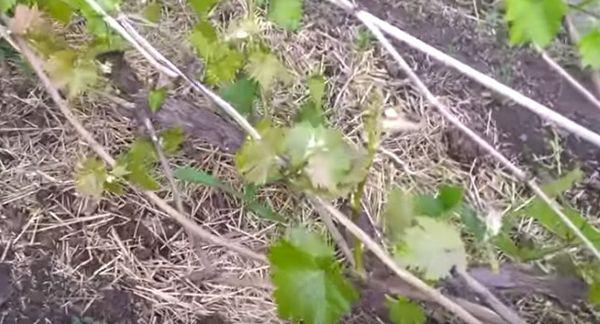

Mature brushes can be covered with a fine mesh. Special traps are installed against wasps, and bioacoustic devices are placed on the territory of large farms.
Preparing for winter
In regions where the temperature in winter drops below minus 22 degrees, the bushes must be covered with plastic wrap. You need to cover so that the film does not touch the bushes. Remove the shelter after all the snow has melted. In warm areas, there is no need to shelter the grapes. There it is enough to mulch the soil or insulate the roots.
Preventive spraying
Despite its high resistance to many diseases, the variety must be subjected to preventive spraying. Treatment with anti-mite drugs and fungicides is carried out before and after flowering.
The third stage of spraying is carried out during the formation of the berries. It is recommended to spray from a distance of 30-40 cm.
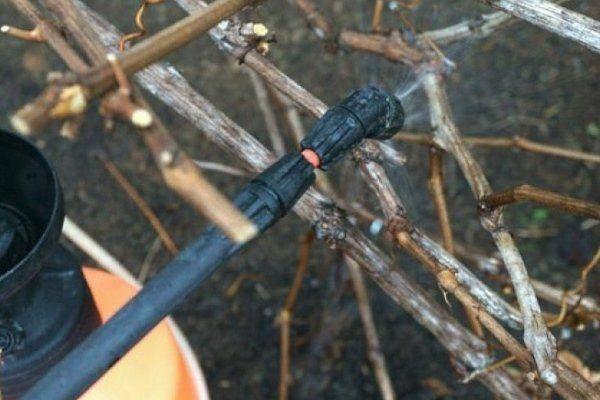

Mulching
To keep the soil loose and not evaporate moisture, use mulch. For this purpose, dry leaves, straw or sawdust are suitable.
Garter
Experienced gardeners recommend growing Nadezhda Azos using a single-plane trellis, as this is the most convenient and effective way to tie. It is not difficult to assemble it yourself. The wire on the trellis is tied up so that the first row is 40 cm from the ground, the rest every 45 cm.
Landing rules
For grapes of the hybrid form "Nadezhda AZOS", a fertile and light soil with high-quality drainage and a distant location of groundwater is needed.
The rules for planting grapes are as follows:
- It is recommended to plant plants in the spring, after the soil dries and warms up. Planting in the southern regions is recommended from 5 to 20 May, and for the northern regions, the optimal period starts from mid-May.
- For additional protection of the vineyard, it is advisable to plant berry and fruit plants that will contribute to snow retention in winter.
- Immediately before planting, the root system of the seedling should be soaked in water at room temperature for a day, and then the main roots in the lower part of the heel should be shortened to 15 cm and all damaged and dry roots should be completely cut out.
- For planting, pits of standard sizes should be prepared in advance: a width of 80 cm to a meter, and a depth for the entire thickness of the root layer.
- In the pit, it is necessary to make an embankment of soil substrate, which should include soil, humus or compost, superphosphate, potassium chloride or potassium salt.
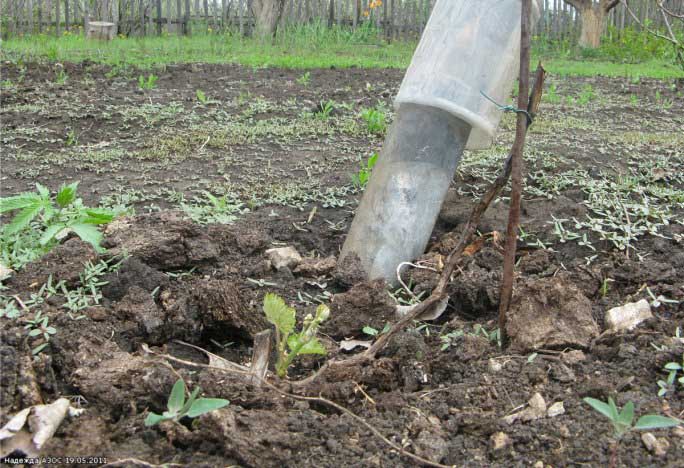

In grape seedlings installed on the embankment, the root system should be straightened, which is covered with nutritious soil and plentifully spilled with water at room temperature (1 bucket). The lower bud of the plant should be located at the level of the soil surface.
If the planting of grape seedlings is carried out correctly, then after a while new shoots are formed on the plant, and the root system begins to work in full force.
Growing features
Description of the variety
The bush is strong and thick.
Grape harvest Nadezhda Azos
The grape leaves are standard five-lobed, but not very large and with drooping. Against the background of ripe large clusters, the leaves seem tiny. Flowers are bisexual.
Beautiful large clusters immediately attract attention. They are characterized by looseness and conical shape. The weight of the bunches can vary from 350 to 750 grams.
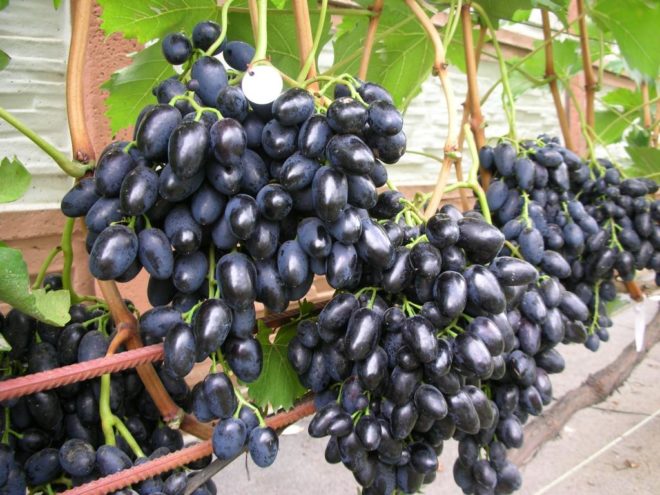

Due to some hardness of the berries, they are well transported, retaining their original shape.
Yield
Nadezhda Azos grape bushes are known for their vigorous and strong growth, so they need to be pruned and shaped. The leaves are large, densely pubescent. They are dark green in color with three to five lobes.
The cone-shaped bunches of the variety are characterized by a loose structure and have thick stalks. The weight of one bunch ranges from 500 to 900 g. There are cases when the mass of the brushes reached 2 kg or more. The older the vine, the larger the brushes ripen on it.
The grapes are oval, dark blue, slightly elongated. The skin of the grapes is of medium thickness, but edible, covered with a velvety bloom. The fruits of this variety are considered large, as they reach 25-28 mm in volume and 8-9 g in weight.
The grade Nadezhda Azos has a pleasant taste, in which sugar content prevails, but a slight sourness is also felt. Tasters give the variety 8.2 points out of 10. For the taste, the berries are fleshy, the seeds are medium in size. They are very beneficial for health: they reduce the risk of diseases of the cardiovascular and respiratory systems, prevent cancer, strengthen the body's defenses. Unripe berries have a tart taste.
Experienced growers have their own secrets of planting and caring for vines. The rules for planting this variety and the conditions for its maintenance do not differ much from those for other varieties. And the schemes for feeding the bushes are quite standard.
Landing dates
Planting grapes is best done in spring, but preparation for it takes place in the fall. In the southern territories of the country, cuttings are planted from late April to mid-May. In the northern regions, it is advisable to wait for a stable air temperature of 10 ⁰С.
The grapes prefer sunny areas with protection from through winds. Shaded areas will increase the growing season of the plant, which will affect harvest time. Hedges, walls of houses, and other green plantings, which will also help to retain snow, help to surround the grapes from drafts. It is unpretentious to the composition of the soil. It develops poorly only in swampy soils or on mountain slopes, among stones.
Before planting, the soil must be dug up. In heavy types of soil, a drainage layer is added. As it you can use pebbles, crushed stone of the middle fraction, expanded clay, etc. It is also recommended to dilute clay soils with river sand in a ratio of 1: 1. The pit, which is dug for grapes in the autumn, is fertilized with humus, rotted manure or other organic matter.
In order for a grape bush to please with a bountiful harvest, you should correctly approach the selection of a seedling. A good seedling should have a strong root system with 4 branches. The diameter of the main branch must be at least 2.5 cm, and each root branch must be at least 1 cm. The approximate length of the seedling is 75 cm. The cuttings must have at least 8 eyes. The length of the lateral shoots is desirable about 5 cm, and they should be developed by about 75%.
A detailed guide to planting Nadezhda grapes:
- Dig a hole 1 m deep and 80 cm wide.
- Add organic fertilizers to the pit.
- Lay out a 4 cm high drainage layer.
- Put a layer of potting soil about 20 cm high on the drain.
- Place the seedling in the hole, gently spreading the roots.
- Cover with the rest of the earth so that the root collar is 5 cm below the surface of the earth.
- Pour 10 liters of water into the root hole.
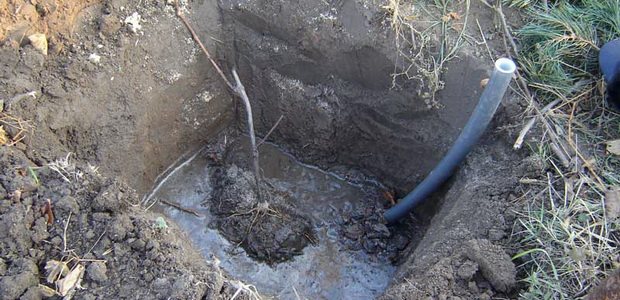

A pit dug for a grape seedling should be 1 m deep
The cultivation of this variety basically does not differ from the generally accepted technology. However, there are some aspects of care and planting that you need to be aware of. Indeed, the success of growing the above-mentioned variety largely depends on this.
The grape Nadezhda Azos is very unique in the sense that it grows and develops quite normally in various soil conditions. This grape can give stable yields both on fertile (black soil) soils and on poor soils (clay and sandy soils).The root system, with timely loosening of the soil around the bush, is capable of developing even in clay and stony areas. In addition to soil, the variety can thrive under the following growing conditions:
- Sufficient and uniform illumination of the vines throughout the entire sunny day. To achieve this goal, it is necessary to plant the variety taking into account the recommended planting scheme and at some distance from high-rise buildings and other shading objects.
- Plot without perennial weeds (wheatgrass, sow thistle, spurge) and a small number of annuals (squid, chicken millet, white gauze).
- The soil should have a moisture content of no more than 41-42%. To do this, you need to take into account the location of groundwater and the possibility of flooding the grape bush with spring melt water and heavy rains.
- It is recommended to place the variety in open areas located on the southwestern and southern slopes.
- It is imperative to choose a site that provides reliable protection from gusty northerly and northeasterly winds.
Required soil
The variety reacts very strongly to the quality of soil cultivation. Tillage should be done as follows:
- In order to exclude soil freezing in winter and drying out in summer, it is necessary to plant grapes in such a way that the root system is located at a depth of 63-70 cm. Therefore, soil cultivation in the place of future grape growing should be carried out precisely at such a depth.
- Soil cultivation is carried out in the fall a few weeks before planting the grapes.
- Taking into account the planting scheme, a pit is prepared with a depth of 64-70 and a width of 56-60 cm. The excavated soil is immediately divided into a fertile and a poor fraction.
- Weeding of the soil around the planting pit is carried out regularly to suppress or completely destroy weeds. The depth of weeding depends on the tool used and can vary from 2 to 7 cm.
- If a lot of sow thistle, wheatgrass or other representatives of perennial weeds grows on a plot prepared for planting, then it makes sense to use Roundup, Hurricane and Tornado herbicides against them.
The main purpose of soil cultivation is to create the best conditions for the survival and subsequent growth of a grape seedling. To do this, proper tillage should help to reduce the number of weeds, loosen the soil and create a fine lumpy layer on its surface.
Sapling selection
High yields of this variety can be obtained using only high-quality seedlings with the following characteristics:
- The seedling must not be more than two years old.
- The surface of the seedling must be exceptionally healthy without fungal and other diseases.
- It is unacceptable to find such pests as phylloxera or spider mites on the seedling.
- The roots of the seedling should be well branched with several large and many small roots.
- The aboveground part of the seedling and especially the root system should not be overdried.
- The seedling must have at least 3 viable eyes.
In order for a grape seedling to quickly take root in a new place and start growing, it is necessary to perform the following work a day before planting:
- With the help of a pruner, the tips of the roots and shoots are cut by 1-1.6 cm.
- Tear off all the leaves on the seedling in order to reduce the evaporation of moisture from the plant.
- The roots are soaked for 5-7 hours in an aqueous solution with the addition of 1-2 ml. the drug Kornevin or 11-13 ml. preparation Energen aqua for 8-9.3 liters. water.
The planting of the variety to a new place of growth is carried out in the fall. The best time is September - first half of October. Spring planting is risky as it can cause the seedling to dry out during the hot summer. All work on planting a seedling can be divided into the following stages:
- A 20 cm layer of crushed stone or gravel should be placed in a pre-prepared planting pit to create a normal drainage layer.
- In order to increase the supply of nutrients and provide the seedling with all nutrients for several seasons, it is recommended to add 7-8.4 kg to the pit. rotted manure mixed with the same amount of black soil.
- The pit is filled with 23-30 liters. water and wait for it to be completely absorbed.
- The seedling must be placed in the center of the pit and, with the root system directed in different directions, it must be covered with loose and fertile soil.
- The aboveground part of the seedling after planting should be 30% below the soil level.
Watering bushes
Watering has a positive effect on the condition and growth of the grape bush. Therefore, to accelerate the growth of fruit vines and the root system of grapes, it is necessary to irrigate in the following order:
- From April to May, you need to water the grapes no more than once a month. At this time, the bush needs to be watered 26-34 liters. water.
- During the summer, you need to water the grapes more often. Therefore, in a month, you need to carry out at least two waterings in the amount of 36-40 liters. water.
- Watering should be stopped two weeks before the start of fruit ripening to protect the berries from unwanted cracking.
- If the autumn is dry enough, then there is a need for one water-charging irrigation. To do this, spend at least 40-54 liters per bush. water.
After watering, it is very important to keep moisture in the soil from excessive evaporation. For this, it is recommended to use mulching material (sawdust, straw, sunflower husks) or to carry out shallow surface loosening of the soil as soon as it dries up a little.
Testimonials
- Vladimir. I used to have classic varieties of grapes growing on my site, but now I completely change it to other types, more modern ones. One of them is Nadezhda AZOS, developed by domestic scientists. To be honest, I do not understand why so few people know about it - for the second year I have been collecting just a huge amount of grapes, I have already begun to even sell it to neighbors. The taste is excellent, the appearance is also excellent! This year I tried to make wine for the first time, but I haven't tested it yet - the fermentation process is in progress. Overall, I am very satisfied.
- Nataliya. I'm not a gardener at all, but my husband and I bought a private house and I decided, since this is the case, to grow grapes near it in the form of a kind of gazebo. I just asked the saleswoman for a variety that would not need to be looked after, because I am not a gardener at all, a summer cottage and all that is not for me. I did everything according to the instructions of the woman, for the third year now I have been rejoicing at the beautiful external view of my site and delicious fruits. Even with a minimum of care, this variety really produces a lot of berries. They are sweet and store well, so I distribute them to all my family and friends. Impressions only positive, negative sides have not noticed for all the time.
- Nastya. Nadezhda AZOS is one of the best young varieties, at one time we could only dream of this. When I was young, in order to get such a harvest in our places around the grapes, it was just necessary not to jump with a tambourine. And here everything is fine, it grows like a weed almost by itself. I advise very much.

